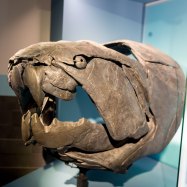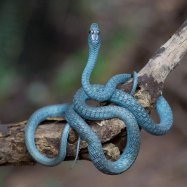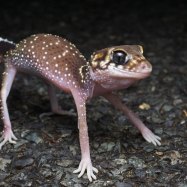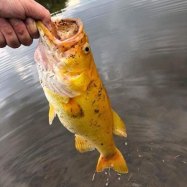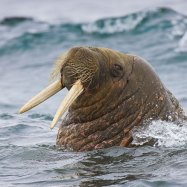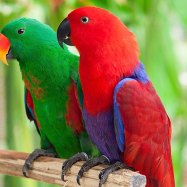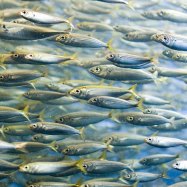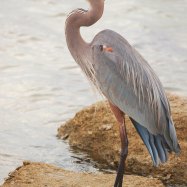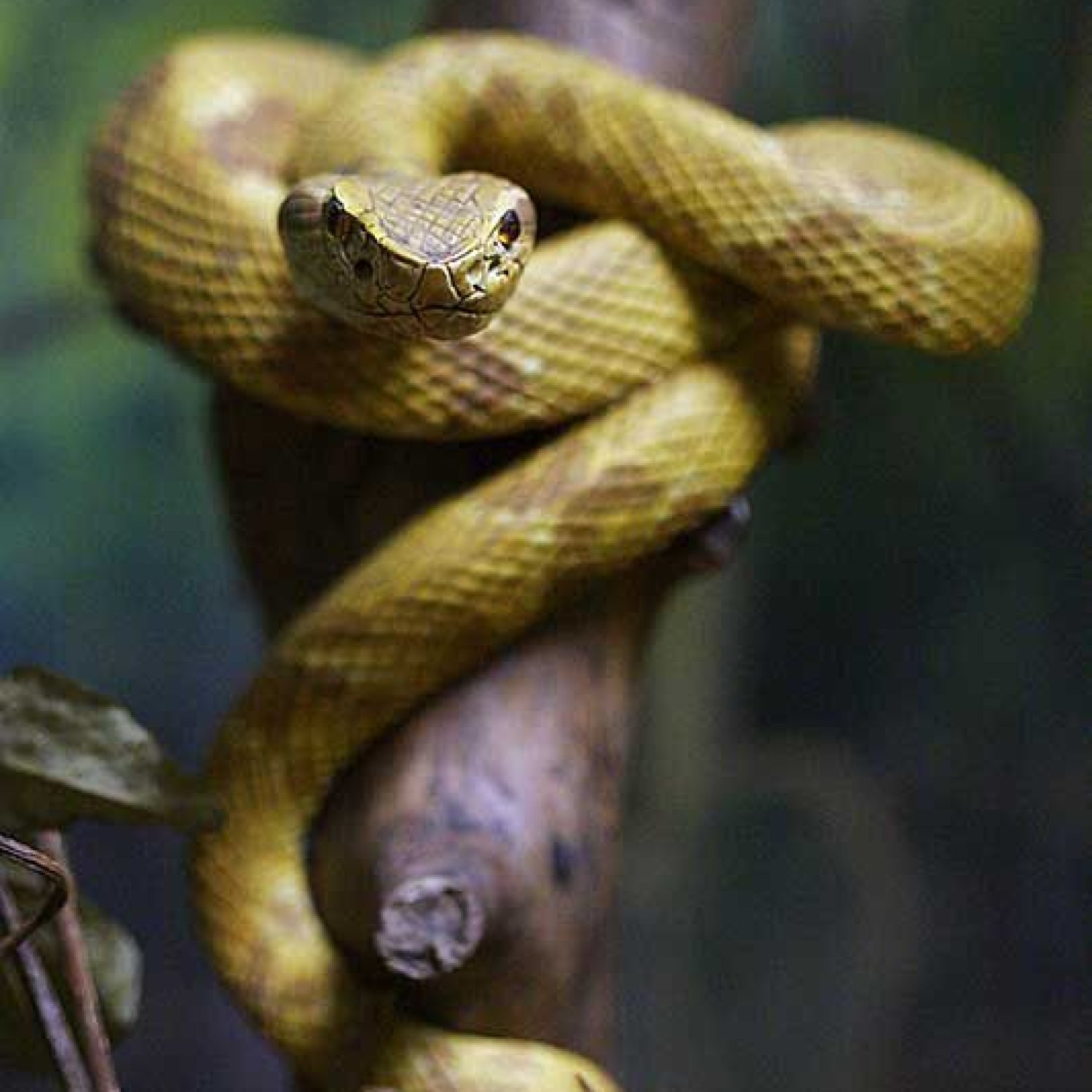
Golden Lancehead
Up to 70 cm (28 in)
The Golden Lancehead, a medium-sized and stout viper found on Ilha da Queimada Grande, is one of the deadliest snakes in the world. Its venom can melt skin and cause internal bleeding, making it a feared animal. With a length of up to 70 cm, this snake can strike fear into the hearts of those who encounter it. This rare species is a reminder of the importance of preserving biodiversity and respecting the habitats of these animals.
Animal Details Summary:
Common Name: Golden Lancehead
Kingdom: Animalia
Habitat: Terrestrial
The Enigma of the Golden Lancehead Snake
Deep in the Atlantic Ocean lies an island shrouded in mystery and fear - Ilha da Queimada Grande, also known as Snake Island. Located about 90 miles off the coast of Brazil, this seemingly ordinary island hides a deadly secret, the Golden Lancehead snake.Scientifically known as Bothrops insularis, this unique species of snake is commonly known as the Golden Lancehead. Its appearance is as mystifying as its habitat, with a golden-brown coloration and a stout, medium-sized body that can grow up to 70 cm (28 in) in length Golden Lancehead.
But what makes this snake so fascinating? Let's take a closer look at the Golden Lancehead and unravel the enigma surrounding it.
A Rare and Isolated Species
The Golden Lancehead is a rare and highly endangered species. It is native to only one place in the entire world - Ilha da Queimada Grande. This small, uninhabited island is home to not just hundreds, but thousands of Golden Lanceheads.The island is only 430,000 square meters in size, making it a tiny speck on the map. The isolation of this island, along with the presence of its natural prey, has allowed the Golden Lancehead to thrive and evolve into a distinct species. It is estimated that there are between 2,000 to 4,000 Golden Lanceheads on the island, making it one of the most densely populated snake habitats in the world.
A Terrestrial Predator
The Golden Lancehead is a highly skilled predator, with a diet that consists mainly of birds. It uses its potent venom and a quick-acting strike to capture its prey, injecting it with enough venom to paralyze and eventually kill its victim Garden Spider.Despite its small size, the Golden Lancehead's venom is known to be one of the deadliest in the world. It contains a high concentration of highly potent toxins that can cause severe tissue damage, bleeding, and ultimately lead to organ failure.
A Unique Adaptation
One of the most unique characteristics of the Golden Lancehead is its adaptation to its habitat. As the island has an abundance of birds, the snake's primary source of food, the Golden Lancehead has evolved to have a more potent venom than its mainland counterparts. This ensures a swift and efficient kill, as its prey does not have the option to escape from the island.Furthermore, the Golden Lancehead's venom has also evolved to become more specialized in attacking birds. The snake's venom is significantly more potent on feathered prey, while its effect on mammals is relatively weaker. This is due to the difference in physiology between birds and mammals, highlighting the Golden Lancehead's specialized evolution.
The Danger of the Golden Lancehead
Despite its lethal venom and fearsome reputation, the Golden Lancehead poses little to no danger to humans. This is partly due to its isolated habitat, making encounters with humans rare. Additionally, the Brazilian government has prohibited anyone from stepping foot on the island, except for research purposes. Even the researchers who are granted permission to study the Golden Lancehead are only allowed on the island for a few days, and they have strict protocols to follow to ensure their safety.The Importance of Conservation
The golden Lancehead's island habitat is under constant threat due to human activity. As the island serves no economic purpose, there have been proposals to utilize it for tourism or development projects. There have also been cases of illegal poaching, with the snakes being sold in the black market for their potent venom.To protect this unique and endangered species, the Brazilian government has taken strict measures to safeguard the Golden Lancehead and its habitat. It is considered a critically endangered species, and any form of hunting, trapping, or trading is illegal and punishable by law.
Furthermore, efforts are being made to educate the public about the importance of protecting this species and its habitat. The Golden Lancehead serves as a crucial part of the ecosystem, and its extinction could have severe consequences on the balance of the island's delicate ecosystem.
Conclusion
In conclusion, the Golden Lancehead is more than just a unique and deadly snake. It is a fascinating example of evolution and adaptation, perfectly suited to its isolated habitat. Its captivating appearance and abilities make it an enigma for researchers and nature enthusiasts alike.The Golden Lancehead serves as a reminder of the delicate balance of nature and the importance of conservation efforts to protect our planet's diverse and endangered species. As we continue to discover more about this elusive species, let us do our part in ensuring its preservation for generations to come.

Golden Lancehead
Animal Details Golden Lancehead - Scientific Name: Bothrops insularis
- Category: Animals G
- Scientific Name: Bothrops insularis
- Common Name: Golden Lancehead
- Kingdom: Animalia
- Phylum: Chordata
- Class: Reptilia
- Order: Squamata
- Family: Viperidae
- Habitat: Terrestrial
- Feeding Method: Carnivorous
- Geographical Distribution: Ilha da Queimada Grande, Brazil
- Country of Origin: Brazil
- Location: Ilha da Queimada Grande
- Animal Coloration: Yellow to golden-brown
- Body Shape: Medium-sized and stout
- Length: Up to 70 cm (28 in)
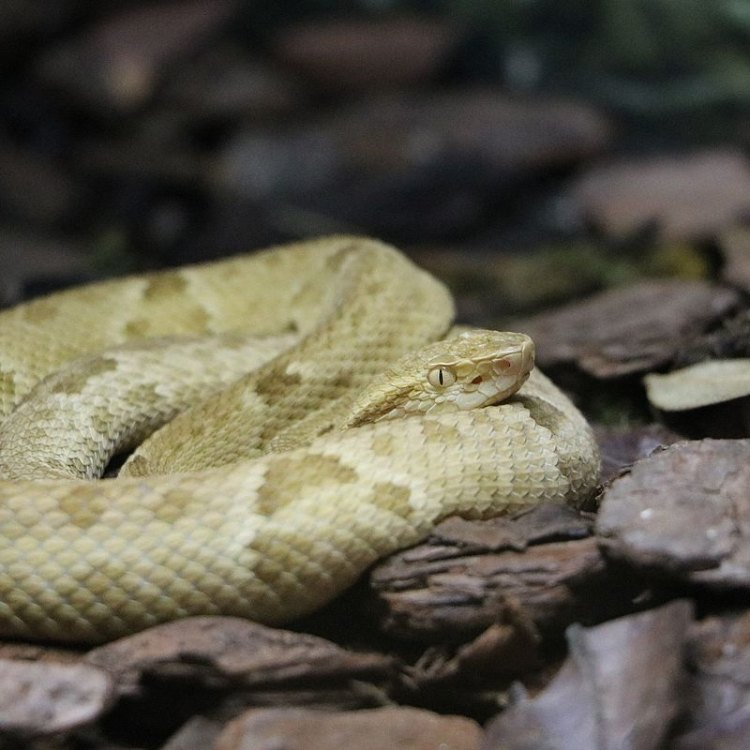
Golden Lancehead
- Adult Size: Medium-sized
- Average Lifespan: Unknown
- Reproduction: Sexual
- Reproductive Behavior: Viviparous
- Sound or Call: Does not produce sound
- Migration Pattern: Non-migratory
- Social Groups: Solitary
- Behavior: Nocturnal and solitary
- Threats: Habitat loss and poaching
- Conservation Status: Critically Endangered
- Impact on Ecosystem: Top predator
- Human Use: No
- Distinctive Features: Golden coloration and lance-shaped head
- Interesting Facts: Only found on Ilha da Queimada Grande, which is also known as Snake Island
- Predator: No natural predators
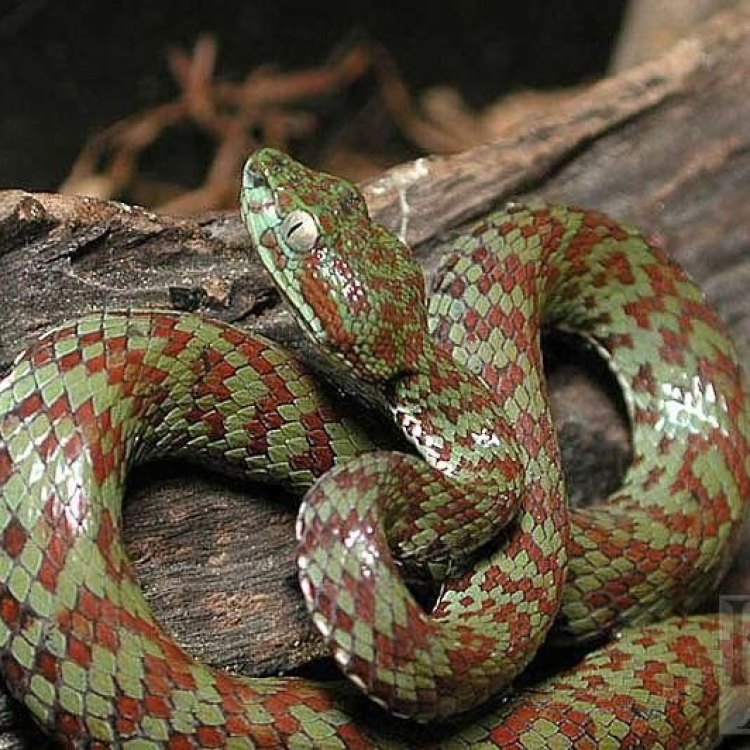
Bothrops insularis
The Enigmatic Golden Lancehead Snake: A Rare and Mysterious Species
In the vast and diverse world of reptiles, there are some species that stand out for their unique characteristics and sheer mystery. One such creature is the Golden Lancehead snake, a medium-sized viper that is only found on a single island off the coast of Brazil. This snake is shrouded in myth and legend, and its rarity and distinctive features make it a subject of fascination for scientists and nature enthusiasts alike.The Golden Lancehead (Bothrops insularis), also known as the Ilha da Queimada Grande or Snake Island pit viper, can only be found on a small island in Brazil called Ilha da Queimada Grande PeaceOfAnimals.Com. This island, located about 90 miles off the coast of São Paulo, is only 430,000 square meters in size, and is home to thousands of these elusive vipers. The island, also known as "Snake Island," is completely uninhabited by humans, making it the perfect sanctuary for these snakes.
So what makes the Golden Lancehead so unique and mysterious? Let's delve into the fascinating details and amazing facts about this rare and intriguing species.
Size and Appearance
The Golden Lancehead is a medium-sized snake, with adult individuals reaching an average length of about 28 inches. However, some specimens have been recorded to grow up to 46 inches in length. Unlike other vipers, this species has smooth scales and a slender body, making it look more like a harmless grass snake at first glance.
But the most striking aspect of this snake is its golden coloration. The scales of the Golden Lancehead range from a pale yellow to a deep golden hue, which gives it its name. This color makes it blend perfectly with the dry and rocky terrain of its island home, making it difficult to spot Goral.
Another distinctive feature of this snake is its lance-shaped head, which gives it its other common name, Lancehead. This feature, coupled with its golden color, makes it easy to distinguish from other venomous snakes found in Brazil.
Lifespan and Reproduction
One of the most intriguing mysteries surrounding this species is its lifespan. Due to the difficulty in studying them in their natural habitat, scientists are still unsure about the average lifespan of the Golden Lancehead. However, it is estimated that they may live up to 20 years in the wild.
The reproductive behavior of this species is also fascinating. The Golden Lancehead is a sexually reproductive species, with females giving birth to live young. This type of reproduction, known as viviparity, is rare among snakes, making this species even more unique.
Behavior and Social Groups
The Golden Lancehead is a solitary snake. It spends most of its time hidden in the rocks and plants, only coming out at night to hunt for prey. This behavior is why it is also considered a nocturnal species.
These snakes are also non-migratory, meaning they stay on the island all year round. Their limited range has also led to a decrease in genetic diversity, making them more vulnerable to environmental changes and diseases.
Threats and Conservation Status
The Golden Lancehead snake faces a range of threats, the most significant being habitat loss. As humans continue to expand and develop coastal areas in Brazil, the natural habitat of these snakes is declining rapidly. This has also led to a decrease in their prey and breeding opportunities.
Poaching is another major threat to this species. Due to the high demand for exotic and rare animals, these snakes are at risk of being captured and sold in the black market. This not only affects their numbers but also disrupts their natural behavior and social structure.
Because of these threats, the Golden Lancehead has been listed as Critically Endangered on the International Union for Conservation of Nature (IUCN) Red List. The Brazilian government has also placed strict regulations on visiting the island, with only a few researchers and scientists being granted access.
Impact on Ecosystem
As top predators, the Golden Lancehead plays a crucial role in maintaining the balance of the island's ecosystem. These snakes mainly feed on birds, lizards, and small mammals, keeping their populations in check. Without the Golden Lancehead, the island's biodiversity would be significantly impacted, leading to a domino effect on the entire ecosystem.
Moreover, the venom of these snakes also plays a vital role in controlling rodent populations. As these snakes are immune to their own venom, they can safely prey on rodents, which are potential carriers of diseases and pests.
Human Use
Despite its rarity and unique features, the Golden Lancehead is not used for any human purposes. Due to its isolated habitat and restricted access, it has never been used for medical research or as a pet. And given its highly venomous nature, humans are advised to maintain a safe distance from this species.
Interesting Facts
Other than its rarity and distinctive features, the Golden Lancehead has several other interesting facts that add to its enigmatic nature.
- The island where these snakes are found, Ilha da Queimada Grande, is off-limits to the public. This is because it is considered one of the most dangerous places in the world, with one snake for every square meter of land.
- The venom of the Golden Lancehead is highly potent and can kill humans quickly. However, no deaths have been recorded from its bite since humans rarely encounter these snakes.
- Despite being deadly, the venom of the Golden Lancehead is being studied for its potential medical benefits. Components of their venom have been found to be effective in treating heart disease and high blood pressure.
- There are no natural predators for the Golden Lancehead. However, the invasion of non-native species, such as cats and monkeys, could pose a threat to their survival.
In conclusion, the Golden Lancehead is a truly extraordinary and rare species that continues to baffle and fascinate humans. Its beauty, uniqueness, and important role in the ecosystem make it imperative to protect and conserve this mysterious snake. With the efforts of scientists and the government, hopefully, the Golden Lancehead can continue to thrive and remain a symbol of wonder and awe.
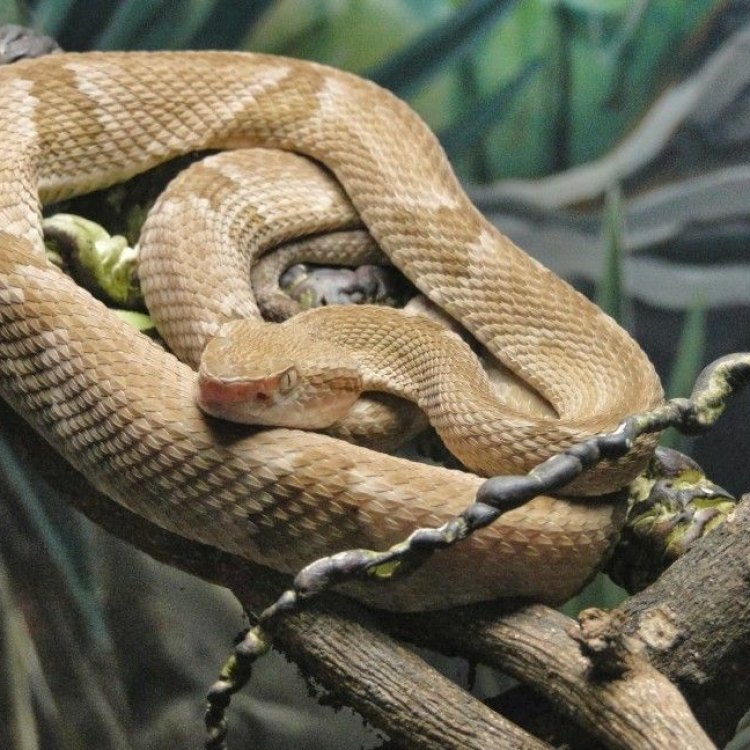
The Enigma of the Golden Lancehead Snake
Disclaimer: The content provided is for informational purposes only. We cannot guarantee the accuracy of the information on this page 100%. All information provided here may change without prior notice.

